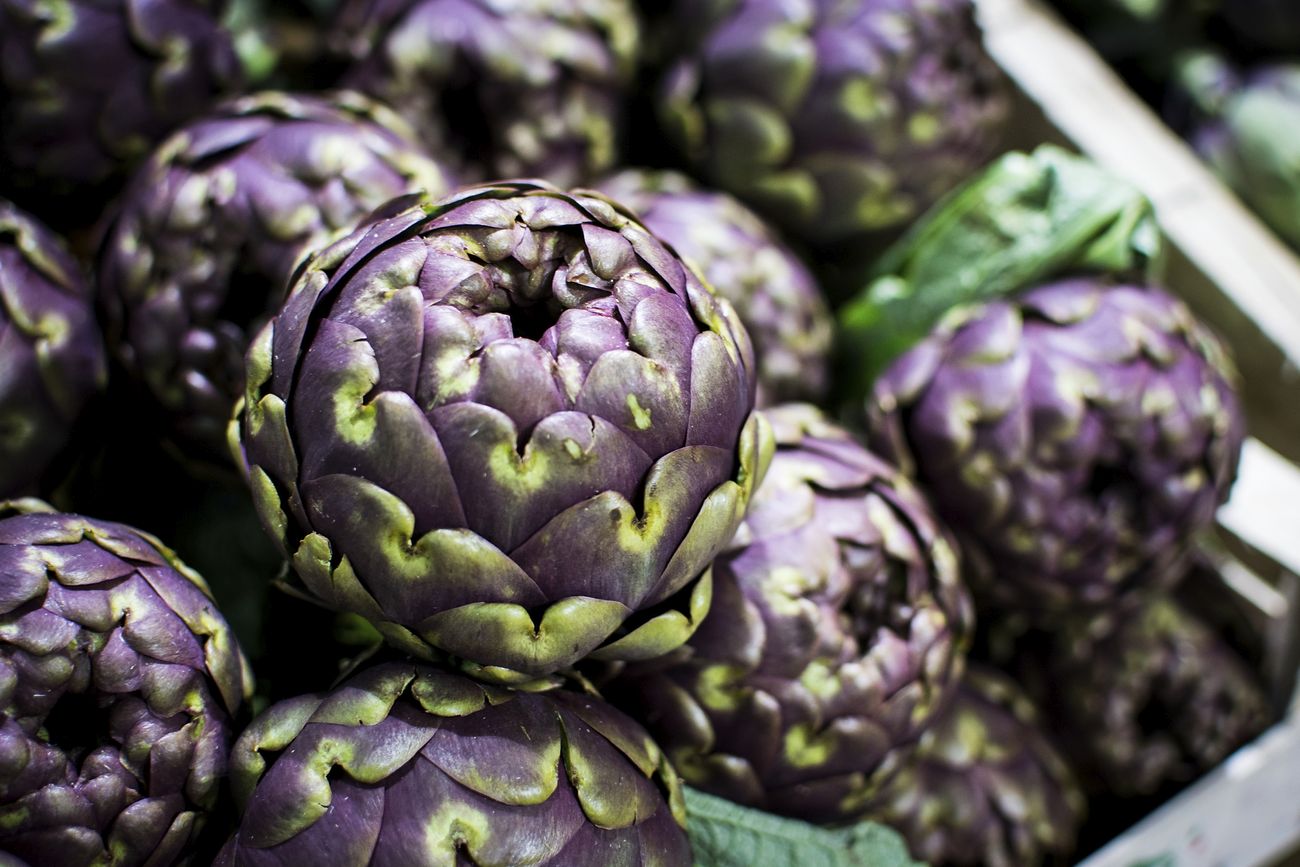If only you were in Rome right now, you’d be enjoying the spring season’s bounty of artichokes, served in a variety of delicious ways. As it turns out, this is also an excellent time to find artichokes in the United States, where the season runs from March through May. Pick up a few artichokes on your next visit to the market, but first, read on for inspiration for one of Italian cuisine’s favorite vegetables.

1. Carciofi alla Romana, or Roman-style artichokes, are an ancient treat
Romans have been eating artichokes in this style for millennia. There are a few tricks to learn when preparing this standard-bearing side dish or snack at home, which I’ve helpfully broken down into a step-by-step process:
- Set out your mise en place with artichokes, a bowl of water, lemons, garlic, parsley, mint, olive oil, and salt and pepper.
- Squeeze some lemon into the bowl of water and rub the lemon against your hands and fingers (to prevent staining).
- Trim off the bottom of the stem of each artichoke.
- Peel off the hard outer leaves of each artichoke, stopping when you reach the tender inner leaves.
- Slice off the top of the remaining leaves.
- Gently open a space in the middle of the leaves to reach the choke, the fuzzy, not-fun-to-eat part of the vegetable.
- Using a small spoon, corer or paring knife, gently remove the choke.
- Peel the stem and round off the end of the artichoke with the paring knife.
- Once prepped, place the artichokes in the bowl of lemon water to retain their color.
- Roll the parsley and mint and gently slice the herbs.
- Finely chop the garlic.
- Remove the artichokes from the bowl.
- Combine the herbs, garlic, and salt and pepper, and stuff the mixture inside the cavity of each artichoke.
- Place the artichokes upside down in a deep pot (stem side up), being careful not to lose the filling.
- Pour olive oil in the pan to cover the bottom of the artichokes and heat the pan for a few minutes, allowing the artichokes to gently fry.
- Add enough water to cover the bottom half of the artichokes.
- Cover the pot and bring to a boil.
- Lower the heat to medium-high to retain a low boil, and cook for 30 minutes (making sure that some liquid remains in the pot; add a little water if needed).
- After 30 minutes, remove from heat, serve and enjoy.
2. Artichokes are high in fiber, among their health benefits
It’s not surprising that artichokes, which are native to the Mediterranean regions, figure into the healthy Mediterranean diet. Their benefits include being high in fiber, which improves gut health, and studies have shown that they can help lower cholesterol. Artichokes are also low in calories, so they can be part of a healthy diet to promote weight loss. For those who want the benefits of artichokes without the somewhat involved process of preparing the vegetable, as described above, artichoke hearts are widely available and are a great addition or base for salads, pastas and more. The health benefits mean that there are now many products on the market touting artichoke as a superfood, as well as artichoke-inspired supplements.

3. In Rome, artichokes aren’t just eaten; they’re celebrated
Rome’s annual artichoke festival, Sagra del Carciofo Romanesco, just occurred this past weekend, marking its 70th year. Should you happen to be in Italy right now, there’s still time to visit another artichoke fest—the annual Tuscan celebration of all things artichoke takes place next weekend, April 21-23, 2023, in Chiusure. Sicilians celebrate the vegetable April 23, 2023, in Cerda, Palermo.
4. California has its own Artichoke Festival
Italians aren’t the only ones who’ve used the artichoke as an excuse to throw a good party. The Artichoke Festival in Monterey, CA dates back to 1959. This year’s event takes place June 10-11, 2023, with the pun-inspired theme “Thistle Be Fun!” (Artichokes are considered a member of the thistle family.) The weekend event will feature chef demonstrations, live music performances, a comedy stage, and lots of artichoke merchandise for sale.
5. Italians even turned artichokes into a liqueur
You’ve probably seen bottles of Cynar at your favorite restaurant or bar–or maybe even in your home bar. This popular bitter amaro counts artichoke as a base for its alluring mix of botanicals. The botanical identification for artichokes, Cynar scolumus, gave the drink its name. Venetian entrepreneur Angelo Dalle Molle is credited with creating the bittersweet spirit in 1952. Because it’s bittersweet and relatively low in alcohol (16.5%), Cynar is consumed as either an aperitivo or a digestivo. It’s also become a popular ingredient in cocktails, including a Negroni, with Cynar subbing in for Campari or another bitter, and a Spritz, with Cynar instead of Aperol. Try making a Cynar Negroni or Cynar Spritz at home:
Cynar Negroni
Over ice in a mixing glass, stir together:
- 1 oz. gin
- 1 oz. red vermouth
- 1 oz. Cynar
Strain and serve over ice with expressed lemon peel.

Cynar Spritz
In a large glass chocked with ice, add:
- 2 parts Prosecco
- 1 part Cynar
- a splash of seltzer
Stir, top with a slice of citrus.
6. Italians have many preparations for artichokes
While Carciofi Alla Romana is the best-known of Italy’s artichoke dishes, chefs and cooks love to play with the flavors and unusual texture of artichoke. Carciofi Al Forno, for instance, is an artichoke stuffed with breadcrumbs and pecorino romano, a familiar dish not only for Romans but for Italian-Americans. In fact, it’s one of the dishes that immigrants brought to the States without changing much about it.

7. Artichokes pair well with brie
An Italian food writer once sent me a recipe for brie-stuffed artichoke. He admitted that it hardly qualifies as Italian given the presence of French cheese, but as he noted, it’s a delicious combo. This isn’t exactly news to anyone who has enjoyed a creamy, cheesy artichoke dip, but I love this recipe for staying true to its Roman origins in preparation—up until the brie is added. Do try this at home:
Ingredients:
- Good quality brie
- Cream
- Thyme
- almond flakes
- egg yolk
- grated Parmigiano Reggiano
Directions:
- Preheat oven to 350°F.
- Boil prepared artichokes in salted water for 10 minutes.
- Remove from water and drain well, upside down in a colander.
- Remove rind from brie
- Over low heat, mix brie with a small glug of cream, constantly stirring until the cheese has melted
- Remove from heat
- Stir in egg yolk, Parmigiano, thyme and crushed almonds
- Add the mixture to the artichokes and place in an oiled baking dish
- Place in oven on a lower rack to prevent the top from burning and cook for 10 minutes, until the cheese mixture has transformed into a golden crust
8. Reports about the arrival of the artichoke in America vary… widely
I wouldn’t recommend trying to trace the history of artichokes being grown in the United States unless you’re prepared to go down a few rabbit holes. Depending on the source, artichokes were introduced to the New World by French immigrants settling in the Louisiana Territories in the early 1800s, or by Spanish or Italian immigrant farmers in California in the 1800s, among other theories. However they got here, artichokes have become a mainstay, with nearly 100 percent of the U.S. crop grown in California.
9. Italy is still the top producer of artichokes worldwide
Data for top artichoke growing countries around the world varies by year and information source, but most comparisons rate Italy as far and away the top producer of artichokes, followed by Egypt and Spain.
10. Choose your artichoke wisely
Now that you’re in the mood to make your own artichoke dish, use these guidelines when selecting your produce: Pick up a globe, and inspect its weight and color. Choose an artichoke that’s a deep green in color, with a nice weight to it, and leaves that are tight and free of blemishes. Outside of the spring and early summer season, fresh artichokes may have a bit of browning, so inspect the inside leaves and look for a nice greenness of color. Avoid artichokes that are too light or too dry. I recommend using fresh artichokes in a day or two, but if you must store them, sprinkle the globes with water and refrigerate them in an airtight bag for a few days or up to a week if you’re lucky.







